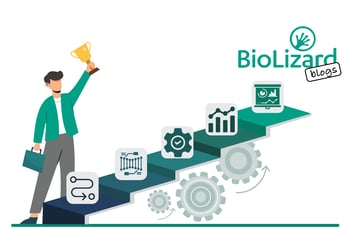The future of multi-omics data analysis
“I see it with the same excitement as I did when next generation sequencing came out.”
That’s what one of our in-house bioinformatics experts had to say when asked about the future of multi-omics data analytics.
And he’s not alone - many scientists agree that omics data will only become more important in the future of biomedicine. At each omics layer, small changes can have large implications: alterations to DNA, RNA, proteins, and epigenetic features can both impact, and be impacted by disease. The power of multi-omics analyses to tease apart these molecular interactions allows us to achieve more unified snapshots of biological processes within cells or tissues - which holds great potential for translational research.
So, let’s dive in! What will the future bring for multi-omics analysis?
1. New technologies
The development of new technologies that allow for the capture of ever-increasing amounts of data is already a reality. Today, multimodal single cell analyses are an accepted state-of-the-art technology, and provide resolution power that was unimaginable only a few years ago. This explosion of new tech is a trend that we expect to continue.
In order to handle the massive output of new sequencing technologies, we expect that the role for machine learning in effective data mining and data analysis will only become more important. Machine learning is already being applied to multi-omics data integration, to allow scientists to uncover hidden patterns within huge datasets that are difficult for humans to interpret. At BioLizard, we have developed a multi-omics integration and analysis application, Bio|Mx, that makes use of machine learning methods to decipher the complex data landscape within multi-omics studies, with a focus on helping scientists to efficiently integrate and analyze multi-omics data to accelerate biomarker discovery, improve drug development, and broaden understanding of disease processes.
Of course, in line with our best practices from the last blog in this series, our AI-based application also includes an intuitive interface that allows easy data exploration and analysis without requiring any coding expertise. We are convinced that this will also be an important development in the field - the development of new technologies that combine human input and collaboration with artificial intelligence applications - and we’re not alone in thinking that there is a need for such technologies. Especially if they don’t demand coding expertise, technologies that bridge human input with the power of machine learning have the potential to help scientists make more data-driven decisions to fuel scientific discovery.
2. More data
Scientists have already collectively produced a huge amount of data spanning across different populations, tissues, and omics levels. However, there are still many areas yet to be explored.
For one, diversity within datasets can be improved. The majority of existing data is from populations of European descent, and so collecting data from a broader population range has the potential to provide a more representative understanding of impacts of both genetic and external factors on disease susceptibility and progression. In addition, collection of more, and longer-term, longitudinal and time-course data could provide improved understanding of the development of different diseases.
Multi-omics analysis of the microbiome is also a rapidly emerging research area with great potential for informing human and animal health and disease, as well as understanding ecosystem processes. The concept of a “holobiont”, which includes both the host and the microbiome living in or on it, has been around for a while, but has steadily been gaining traction in the scientific world. We already know that microbiota can impact expression of host features or drive post-translational modifications, impact drug pharmakokinetics and pharmacodynamics, and more. Integrating microbiome analyses into multi-omics datasets is therefore an exciting emerging field of research that holds a lot of promise for providing new insights into health and disease.
.png?width=3823&height=2084&name=MO_blog3%20(2).png) Potential uses of integrated multi-omics data. Adapted from Kreitmaier et al. 2022.
Potential uses of integrated multi-omics data. Adapted from Kreitmaier et al. 2022.
However, the great boom in sequencing of microbial genomes over the last decades has also come with challenges. It’s essential to perform careful quality control when wading into this field, as highlighted by a recent preprint by Gihawi and colleagues that demonstrates the importance of careful selection of sequence databases. This preprint called out flaws in a 2020 Nature paper, in which human reads were erroneously marked as bacterial reads in some public databases. The impact of this incorrect labeling on the main findings presented in the original Nature publication is still being untangled, and authors of the original paper have already shared a rebuttal. Nonetheless, this affair represents a cautionary tale on quality control.
3. Multi-omics data analysis in the clinic
Figuring out how to effectively utilize multi-omics data for clinical decision making is still a work in progress, but one that holds great potential for developing data-driven personalized medicine. Being able to leverage non-traditional biomarkers such as chromatin state, patient genetic backgrounds, and gene expression at the moment of sampling could allow for the development of better or more personalized therapies for patients.
However, in order to make this a reality, it will be essential to address some practical challenges - like quick data integration and user-friendly data visualization - before the direct use of complex multi-omics datasets in patient care can become widespread... Which we’re actively working on at BioLizard!
In the future, harnessing multi-omics clinical data has the potential to boost data-driven treatment and enhance diagnostic accuracy, to benefit patients across a range of disease areas.
Your future with multi-omics data analysis
It’s already clear that multi-omics analyses have huge potential to drive forward biomedical discoveries, predict disease subtypes and outcomes, classify patients into risk or therapeutic treatment groups, and more. At BioLizard, we have years of experience in multi-omics analysis, and are actively engaged in expanding the multi-omics frontier by developing new algorithms and tech that will ultimately help scientists discover better, more data-driven therapies and diagnostics to patients.



